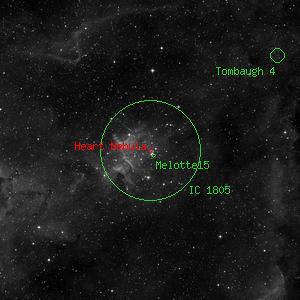IC 1805

Overlaid DSS image of IC 1805, 60' x 60' with north at top and west to the right
Aladin viewer for the region around IC 1805
Heart Nebula Cluster
Melotte 15, Mel 15, Collinder 26, Cr 26, C 0228+612, OCl 352
Melotte 15, Mel 15, Collinder 26, Cr 26, C 0228+612, OCl 352
| Type | Open Cluster |
|---|---|
| Magnitude | 6.5 |
| Size | 20' |
| Right Ascension | 2h 32' (2000) |
| Declination | 61° 28' N |
| Constellation | Cassiopeia |
| Description | Cl, co, eL neby extends f |
| Classification | III 3 p n |
Observing Notes
Object Note
Nov 2, 2020
IC 1805 is the star cluster at the center of the nebula complex Sharpless 2-190, the Heart Nebula. The entire complex encompassing well over a degree in RA and two degrees in declination.
There are multiple associated catalog numbers encompassing this nebula complex. NGC 896 being the bright knot in the northwest reach. IC 1805, the embedded star cluster at the center was first described by E. E. Barnard in the late 1890's. There is also IC 1795, a bright knot of emission to the northern side of the complex also described by Barnard, and IC 1831, a faint streamer of emission to the northeast discovered by Max Wolfe in 1906.
Harold Corwin
Barnard's RA is off by about 50 seconds of time (this seemed to happen a lot with his observations; see e.g. IC 1802). Still, the cluster, immersed in a huge nebula, is too obvious to be missed. Barnard called it "compressed", so I've taken it to be the small cluster centered to the east of HD 15558. Brian Skiff puts the HD star closer to the center, and so takes the cluster to include many more of the surrounding stars. In this case, the group that I include is just the core of the cluster. I suspect Brian is right.
Also see IC 1831 for another possible object in the area.
Courtney Seligman asked about this in June 2021, noting that the nebula to the east of the cluster is often called the "Heart Nebula". I did a little more digging and wrote back:
"I have not found a paper of Barnard's that discusses this cluster and nebula, so assume that it was one of the "many MS communications" sent to Dreyer without otherwise being published. So, what we see in the 2nd IC is all there is, unless we can turn up a paper by Barnard that we haven't seen yet.
The cluster is shown in Plates 8 and 9 in Lick Publication XI, Barnard's 1913 compilation of his photographs of the Milky Way and comets made at Lick from 1892 to 1895. However, there is no nebulosity apparent on either plate, so I am doubtful that these are his discovery images for IC 1805. Could be wrong, of course, and Barnard does mention the cluster in passing in his short discussion of Plate 9: 'There is a clustering tendency among the stars at various points on the plate, especially about three degrees above 33 and 34 [H VI 33/34 = NGC 869 and NGC 884, the Double Cluster, which see], where a feeble imitation of the double cluster appears.' The eastern of the two 'feeble' clumps is IC 1805, the western is IC 1824 = NGC 1027.
In any event, the nebula is indeed part of the IC object, though the cluster is the main show in the old catalogue."
Doing more digging, I found that Barnard himself identified both clusters and made the connection between NGC 1027 and IC 1824 in his Milky Way Atlas (Region/Plate 2; see it online at http://www.library.gatech.edu/barnard/) where he also discusses the field around the clusters, mentioning the faint nebulosity. He does not, however, give a reference to his discovery of the IC objects, so we are still left to assume that Barnard sent a note to Dreyer about them.
Other Data Sources for IC 1805
Associated objects for IC 1805
Nearby objects for IC 1805
10 objects found within 120'
| Berkeley 65 | Czernik10 | Czernik11 |
| Czernik9 | Heart Nebula | IC 1795 |
| Maffei I | Melotte15 | |
| Tombaugh 4 |
Credits...
Drawings, descriptions, and CCD photos are copyright Andrew Cooper unless otherwise noted, no usage without permission.
A complete list of credits and sources can be found on the about page
IC 1805